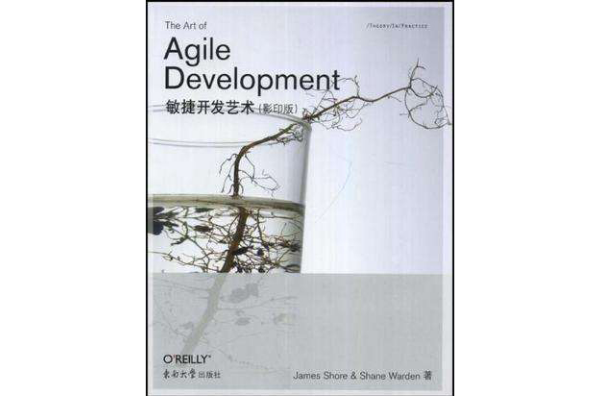《敏捷開發藝術》是2008年8月1日東南大學出版社出版的圖書,作者是(美國)肖爾 (James Shore) (美國)活登 (Shane Warden)
基本介紹
- 書名:敏捷開發藝術
- 頁數:409頁
- 出版社: 東南大學出版社
- 裝幀:平裝
圖書信息,作者簡介,內容簡介,媒體評論,目錄,
圖書信息
出版社: 東南大學出版社; 第1版 (2008年8月1日)
外文書名: The Art of Agile Development
平裝: 409頁
正文語種: 英語
開本: 16
ISBN: 7564112417, 9787564112417
條形碼: 9787564112417
尺寸: 23 x 17.6 x 2.2 cm
重量: 662 g
作者簡介
作者:(美國)肖爾 (James Shore) (美國)活登 (Shane Warden)
內容簡介
《敏捷開發藝術(影印版)》是講解如何利用敏捷開發方法構建高價值軟體的實用指南,描述了什麼是敏捷開發,以及為什麼它能幫助軟體項目獲得成功的原因。該書還將開發者、項目經理、測試者和客戶所需信息整合在一起,以便直接運用。
《敏捷開發藝術(影印版)》展現了敏捷過程的完整視圖,基於作者多年的極限編程(XP)經驗,直截了當地提出關於計畫、開發、交付和管理等多方面實施的建議。它為開發者和測試者提供實用的技術練習,同樣也為非技術背景讀者提供了充分的信息。作者還介紹了如何處理敏捷開發中的棘手問題:建立團隊成員之間的協作和信任關係。
《敏捷開發藝術(影印版)》針對下列問題給出明確的答案:
如何採用敏捷開發?
我們是否真的需要結對編程?
應該基於何種度量(metrics)報告?
如何讓我們的客戶共同參與項目?
我們應該撰寫多少文檔?
何時設計架構?
作為非開發者,該如何與敏捷團隊合作?
我的產品路線圖在哪裡?
QA如何適應敏捷開發?
無論你是敏捷團隊的一員,還是剛剛對敏捷開發產生興趣,這《敏捷開發藝術》具備了你需要的所有實用技巧。它向你說明引入XP的過程,詳細描述其中每一項實踐,並且討論了如何修改XP和創建自己的敏捷方法等相關原則。該書將隨著你的經驗提升而不斷深入,首先教你規則,然後告訴你如何突破它們,當掌握了敏捷開發藝術之時,最終便可以擯棄一切規則。
媒體評論
“我會將此書送給我訪問過的每一個團隊。”
—— Brian Marick,Exampler Consulting ...
目錄
Preface. xiii
Part I. Getting Started
1. Why Agile? 3
Understanding Success 4
Beyond Deadlines 4
The Importance of Organizational Success 5
Enter Agility 6
2. How to Be Agile 9
Agile Methods 9
Don’t Make Your Own Method 10
The Road to Mastery 11
Find a Mentor 12
3. Understanding XP 15
The XP Lifecycle 18
The XP Team 27
XP Concepts 39
4. Adopting XP43
Is XP Right for Us? 43
Go! 51
Assess Your Agility 62
Part II. Practicing XP
5. Thinking 69
Pair Programming 71
Energized Work 79
Informative Workspace 83
Root-Cause Analysis 88
Retrospectives 91
6. Collaborating 99
Trust 102
Sit Together 112
Real Customer Involvement 120
Ubiquitous Language 124
Stand-Up Meetings 129
Coding Standards 133
Iteration Demo 138
Reporting 144
7. Releasing153
“Done Done” 156
No Bugs 160
Version Control 169
Ten-Minute Build 177
Continuous Integration 183
Collective Code Ownership 191
Documentation 195
8. Planning 199
Vision 201
Release Planning 206
The Planning Game 219
Risk Management 224
Iteration Planning .. 233
Slack 246
Stories 253
Estimating 260
9. Developing271
Incremental Requirements 273
Customer Tests 278
Test-Driven Development 285
Refactoring 303
Simple Design 314
Incremental Design and Architecture 321
Spike Solutions 331
Performance Optimization 335
Exploratory Testing 341
Part III. Mastering Agility
10. Values and Principles 353
Commonalities 353
About Values, Principles, and Practices 354
Further Reading 354
11. Improve the Process 357
Understand Your Project 357
une and Adapt 358
Break the Rules 359
12. Rely on People 361
Build Effective Relationships 361
Let the Right People Do the Right Things 363
Build the Process for the People 364
13. Eliminate Waste 367
Work in Small, Reversible Steps 367
Fail Fast 369
Maximize Work Not Done 370
Pursue Throughput 371
14. Deliver Value 375
Exploit Your Agility 375
Only Releasable Code Has Value 376
Deliver Business Results 378
Deliver Frequently 379
15. Seek Technical Excellence381
Software Doesn’t Exist 381
Design Is for Understanding 382
Design Trade-offs 383
Quality with a Name 383
Great Design 383
Universal Design Principles 384
Principles in Practice 387
Pursue Mastery 388
References 391
Index... 397

